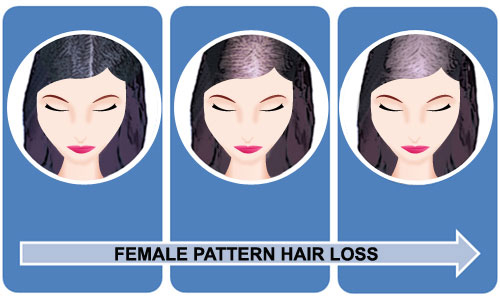What Is Female Androgenetic Hair Loss?

A woman's hair is often perceived as integral to her self-image, confidence, and beauty. The thousands of hair products and adornments testify to how important this one physical asset is to so many women, from infancy until old age. Heredity, aging, environment, and other causes can and do affect the color, texture, and yes, unfortunately, even the amount of hair loss experienced throughout a lifetime. 2
One type of female hair thinning and loss is female pattern hair loss (FPHL), which is also referred to as androgenetic alopecia or female AGA—although some experts now refer to only cases with confirmed androgen hormone increases as female AGA. This type of hair loss in women typically presents as progressively worsening, diffuse hair thinning in the front and crown areas of the scalp. 30

The part width gets gradually wider while the front hairline is preserved in most cases of FPHL. However, in women with androgen levels similar to that of men the pattern of hair loss in female AGA becomes more pronounced and creates a triangular, Christmas tree pattern of hair loss with the base of the triangle representing the greatest amount of thinning located just behind the front hairline. The hair loss is less moving back from the hairline, with the tip of the triangular Christmas tree typically at the crown. 22, 30, 99
Other clinical signs and factors that are prevalent in FPHL include: 100
- Focal atrichia. Areas of total hair loss on the scalp the size of a pencil eraser; present in 75% of late onset FPHL.
- Age of onset. If hair thinning begins under age 30, it is also more likely that other symptoms of excess androgens will be present. In early-onset the FPHL is considered to be the counterpart to male pattern hair loss. After age 40, or late-onset FPHL, may be more indicative of age-related hair loss without symptoms of excess androgens.
- Hair pull test. Typically positive only in affected areas (central top of scalp) and not as spread out as in telogen effluvium.
- Terminal/vellus hair ratio. In women not suffering from hair loss, the ratio between normal terminal type scalp hair and the shorter, finer vellus hair is 7:1; in FPHL the ratio is typically 4:1 with some miniaturization of follicles seen on biopsy.
Although there is some disagreement within the scientific community as to the prevalence FPHL, it is a common condition in women that progressively worsens with age. Studies in Caucasians indicate that less than 10% of women under age 30 experience this type of balding, but this increases to 29-42% by age 70. 20
Fortunately, once diagnosed there are a number of conventional treatment options available, including topical minoxidil and phototherapy. Nutritional and herbal therapies may help as well.
Scalp Dermoscopy (aka Trichoscopy) for Diagnosis
Trichoscopy can be used to help diagnose female AGA. This microscopic tool takes a photograph of the scalp and hair. When comparing the areas of the scalp affected by female AGA (top of scalp, hair part) to areas unaffected (occipital area), the pattern found shows: 354
- Increased number of vellus hairs.
- More than 20% of hair shafts show differences in diameter (revealing progressive miniaturization of hair follicles).
- Increased number of hair follicles with only a single hair.
- Pearly white dots, which are enlarged sebaceous glands around miniaturized hair follicles.
- Peripilar halos in early stages of female AGA (subtle brown hyperpigmentation around the hair follicle base, caused by inflammation).
Experts caution that ethnicity must be taken in account when performing trichoscopy. Differences in skin color must be taken in account when looking for signs of hyperpigmentation. In addition, women with darker skin and female AGA also show yellow dots, more white dots, and honeycomb pigmentation. These findings are also linked with more severe cases of AGA (in both men and women). 355, 356
What Else Could It Be?
Non-scarring central hair loss could also be one of the following types of alopecia: 100
- Alopecia areata
- Chronic telogen effluvium
- Telogen effluvium or diffuse alopecia areata caused by secondary syphilis
- Trichotillomania
A good tool to distinguish between FPHL and chronic telogen effluvium is the modified wash test to determine the percentage of vellus hair—which can be as high as almost 59% in FPHL but under 4% in telogen effluvium. In African-American women, central centrifugal cicatricial scarring alopecia can often look like FPHL. 29, 30



